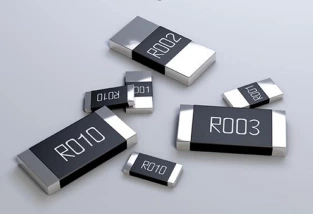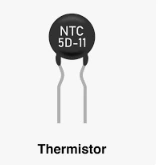Detailed Explanation of the Working Principle of Resistors: A Beginner's Guide
Resistors are one of the most fundamental and frequently used electronic components. They can be found in both simple circuit experiment boards and complex computer motherboards. For beginners who are just getting into electronic technology, understanding the working principle of resistors is a crucial step in laying a solid foundation for their electronic learning.
What is a resistor?

Resistor is a two-terminal component. Its main function is to impede the current in the circuit. By controlling the current size, it can distribute voltage or generate heat.According to Ohm's Law, the resistance value is:
R = V / I
Among them:
R represents resistance (unit: ohm Ω)
V represents voltage (unit: volt V)
I represents current (unit: ampere A)
Detailed Explanation of the Working Principle of Resistors
1. Basic principle
When current flows through a resistor, free electrons in the conductor collide with lattice atoms. These collisions impede the movement of electrons, thereby restricting the current and converting part of the electrical energy into heat energy.
This process reflects the physical essence of resistance - resistance is caused by the obstruction of electron movement due to the microscopic structure within the conductor.
2.Ohm’s Law in Action
Ohm's Law is one of the most fundamental and crucial tools for analyzing and designing circuits. It is not only the key to understanding the working principle of resistors, but also widely applied in various scenarios in actual circuit design. Below, we will elaborate on the practical applications of Ohm's Law from multiple perspectives:
(1)Current-limiting design
When connecting components such as LED lights, sensors and motors, it is necessary to control the current passing through these components by means of resistors to prevent them from being burned out. For example:
- The working voltage of an LED lamp is 2V, the power supply provides 5V, and the required working current is 20mA.
- The required resistance can be calculated using Ohm's Law:R = (Vpower supply - VLED) / I = (5V - 2V) / 0.02A = 150Ω
- This implies that a current-limiting resistor of 150Ω needs to be connected in series to ensure the stable operation of the LED.
(2) Voltage Divider
Voltage division is the process of dividing a higher voltage into multiple lower voltages through two or more series-connected resistors, which is used in scenarios such as analog signal input, ADC sampling, and voltage detection.
Example: Reduce the 12V voltage to 6V for the sensor to use.
- If two resistors of equal value (such as 1kΩ) are used, the midpoint voltage is:Vout = Vin × R2 / (R1 + R2) = 12V × 1k / (1k + 1k) = 6V
(3) Resistor selection and power matching
After determining the resistance value, it is also necessary to calculate the power it consumes according to Ohm's Law to avoid burning out the components:
- Power P = V × I, or P = I² × R or P = V² / R can also be used
- If the voltage across the resistor is 10V, the resistance value is 100Ω :P = V²/ R = 100V²/ 100Ω= 1W
- In practice, a resistor with a power rating of 1.5 to 2 times should be selected, that is, a 2W resistor is safer.
(4) Circuit debugging and analysis
Ohm's Law is also often used for:
- Analyze open circuit and short circuit: Determine whether the resistor is damaged by measuring the voltage/current
- Fault location: Based on the deviation between the expected current and the actual measured value, determine whether the component is abnormal
- Virtual simulation calculation: Input the Ohm's Law formula in circuit simulation software (such as Multisim, LTspice) to quickly simulate the impact of resistance changes on the system
(5) Combined application with other laws
In more complex circuits, Ohm's law is often used in combination with Kirchhoff's laws (KVL, KCL) :
- Analyze the distribution of voltage, current and resistance in parallel and series circuits
- Solve the voltage distribution of complex power grid nodes
- Optimize the circuit design to enhance the efficiency of power utilization
The types and structures of resistors
Resistors can be classified into various types based on their applications, regulation methods, material compositions and structural features. Understanding these different types is of great significance for circuit design and component selection. Starting from the common classification methods, the following comprehensively introduces the main types of resistors and their structural characteristics.
1.Metal alloy shunt resistor
A metal alloy shunt resistor is a device that uses a metal alloy (such as constantan, nichrome, or copper-nickel alloy) as the resistive element. It operates by diverting a portion of the current in a circuit through a low-resistance component, and the voltage drop across the resistor is then measured to indirectly determine the current.
Common subtypes:
(1)Metal Foil Shunt Resistor
- Ultra-High Precision:Features an extremely low temperature coefficient (as low as ±0.2 ppm/°C), making it ideal for high-precision measurements.
- High Stability:Offers exceptional stability under long-term load and high-temperature conditions.
- Low Resistance Range:Typically suitable for resistance values in the milliohm or even micro-ohm range.
- Application Scenarios:Widely used in high-end electronic devices, current sensing modules, instrumentation, aerospace, medical equipment, and more.
(2)Metal Film Shunt Resistor

- Features: High precision (up to ±1%, ±0.1%), low noise, and good temperature stability
- Application: Audio, instrumentation, medical electronics and other occasions with high stability requirements
(3)Slim / Thin Type Shunt Resistor
Compact Design:Ultra-thin structure suitable for circuit board layouts with limited space.
Excellent Thermal Conductivity:Enables rapid heat dissipation, making it ideal for high-current applications.
Low Resistance Values:Supports resistance ranges from several milliohms down to the micro-ohm level.
Application Scenarios:Commonly used in battery management systems (BMS), electric vehicles, DC-DC converters, mobile devices, and more.
2.Variable Resistor / Potentiometer
Variable resistors allow users to manually adjust the resistance value and are widely used in control circuits, such as volume knobs, brightness adjustments, and potential fine-tuning.
Common types:
(1)Potentiometer
- With a rotating or sliding structure, the resistance value can be continuously adjusted
- Structure: Three terminals, with a sliding contact connected at the middle end
- Application: Audio volume, display brightness control, etc
(2)Trimmer / Trimpot
- It is used for fine-tuning circuits and is generally adjusted with a screwdriver
- Application: Calibration, bias adjustment
3.Thermistor
Thermistors are a type of resistor that is sensitive to temperature, and their resistance values change significantly with temperature.

(1)NTC (Negative Temperature coefficient) thermistor
- When the temperature rises, the resistance decreases
- Applications: Overcurrent protection, startup delay, temperature detection
(2)PTC (Positive Temperature Coefficient) thermistor
- When the temperature rises, the resistance increases
- Application: Automatic fuse reset, motor protection
4.LDR / Photoresistor
A photoresistor is a component that is sensitive to the intensity of light.
- Working principle: Enhanced light → Decreased resistance
- Material: Generally cadmium sulfide (CdS)
- Applications: Light-controlled lamps, brightness adjustment, security systems
5.Varistor
A varistor is a voltage-sensitive component. When the voltage exceeds a certain value, its resistance drops sharply, playing a role in surge absorption and overvoltage protection.
- Common material: Zinc oxide
- Application: Power lightning protection modules, surge protectors, household appliances
6.Special packaging and structural forms
(1)Classified by packaging:
-
Through-Hole resistor: Suitable for traditional PCB soldering, it is convenient for replacement and maintenance
- Surface mount Resistor (SMD Resistor) : Suitable for surface mount technology (SMT), it is small in size and has high efficiency in automated production
(2)By shape and structure:
- Axial Resistor: The two pins extend symmetrically, facilitating the use of the plug-in board
- Radial Resistor: The pins are led out from the same side and are mostly used in small circuit boards
The main function of a resistor
Resistors play an indispensable role in circuits. It can not only limit the current and distribute the voltage, but also provide a stable working environment and signal processing capabilities. Understanding the function of resistors is helpful for mastering the core principles of electronic circuit design. The following is a detailed introduction to the main functions and application scenarios of resistors in circuits.
1.Current Limiting
This is one of the most fundamental functions of a resistor. By connecting resistors in series in the circuit, the current flowing through the circuit can be limited, preventing excessive current from damaging the components.
Common applications include:
- In an LED circuit, series current-limiting resistors can control the current passing through the LED and extend its service life
- In the motor or relay starting circuit, prevent excessive starting current from causing impact
2.Pressure division effect
Resistors can proportionally distribute high voltages into lower voltages for use in subsequent circuits. This method is called voltage division and is very common in many low-voltage control systems.
Common applications include:
- Voltage matching at the analog signal input terminal
- Provide appropriate reference voltages for sensors and voltage detection chips
3. Pulling up and pulling down effects
In digital circuits, signal lines are sometimes in a suspended state, making it impossible to determine their logic levels. By connecting pull-up resistors or pull-down resistors, the level can be stabilized at a high or low state to avoid logical errors.
Common applications include:
- The signals at the input pins of the single-chip microcomputer are stable
- Prevent false triggering in the key circuit
4. Signal Conditioning and Attenuation
In analog circuits, resistors can be used to adjust the amplitude of the signal or limit the size of the signal. For example, in combination with capacitors, filters can be constructed to adjust the frequency response; The gain can be set in combination with the amplifier.
Common applications include:
- The volume control knob uses a potentiometer for signal adjustment
- Analog filters are used to remove noise signals
5.Thermal energy release and load simulation
Heat is generated when current passes through a resistor. In some scenarios, resistors are specifically used as heating elements or for simulating loads for testing.
Common applications include:
- High-power resistors are used for load simulation and power supply testing
- Heating resistors are used in electric heaters, low-power heaters, etc
6.Detection and Sensing
Some special resistors can change their resistance values according to the variations of external physical quantities and thus are used in sensors. For example, thermistors are used for temperature detection, photoresistors for light detection, and shunt resistors for current measurement.
Common applications include:
- Temperature detection and control (such as thermistors)
- Automatic adjustment of light intensity (such as photoresistor)
- Current monitoring and protection (such as current sampling resistors
7.Summary
The main functions of resistors in circuits include:
- Control the magnitude of the current and protect the devices
- Distribute voltage to meet the requirements of different circuits
- Stabilize the logic level to prevent false triggering
- Regulate the signal and participate in filtering and amplification
- Release electrical energy to serve as a heating element or dummy load
- Participate in the sensing function to achieve the detection of temperature, light, current, etc
Precautions for the selection of resistors
When choosing the appropriate resistor, the following key parameters need to be noted:
- Resistance value (Ω) : Calculated based on circuit requirements
- Power (W) : It must be higher than the actual power consumed in the circuit, and redundancy of more than twice is often selected
- Accuracy (±%) : The deviation range that determines the resistance value
- Temperature coefficient: Affects stability in high-temperature environments
- Packaging type: such as Through Hole or surface mount (SMD)
Common application examples of resistors
| Application Scenario | Function of Resistor |
|---|---|
| LED driver circuit | Current limiting, LED protection |
| Voltage divider circuit | Provide reference voltage |
| Audio equipment | Control volume, adjust signal |
| Power supply circuit | Start-up resistor, limit inrush current |
| Microcontroller interface circuit | Pull-up/down resistor, stabilize logic level |